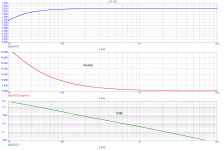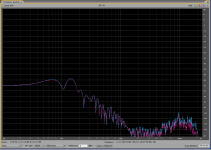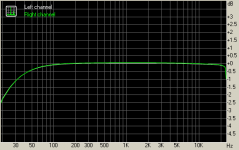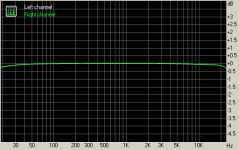Interestingly, I just did a very quick spectrum comparison between cap2 and wire, and there is very little in it, in the LF end. But, there are some very significant variations in the mid-range areas - major differences at several points, for prominent peaks ... 😕
The reason is that the capacitor LF cutoff introduces phase shift --> proper alignment of files with and without LF roll off is then almost impossible.
The "wire.wav" file was not intended for the test, we tested 2 capacitors, well aligned in frequencies and amplitudes.
The "wire.wav" file was not intended for the test, we tested 2 capacitors, well aligned in frequencies and amplitudes.
Ahhh, Pavel, you're going to hate me for this - tried the straight wire version - and it's not up to scratch! Just been going back and forth, back and forth, between cap2 and wire, and cap2 is a clear winner: treble is cleaner, the detail is more clearly defined, the acoustic is coming through with more delineation. The wire version is a subjective 'struggle', I loose track of what the instruments are doing because I have to focus harder to 'see' each one ...
When I first quick listened the files, I started with cap1 and cap2 and I thought cap2 was better. When I listened to cap3, then I knew cap3 is different so cap1=cap2 and I assumed my perception about cap2 better than cap1 was wrong.
When I listened to the wire I was surprised. I know it has sonic superiority but no feeling such as "hey this is good!" such as when several time I played cap2. But when listening for long I can appreciate the wire version more.
Here is a simple test that do not require big preparation: a meter of aluminum versus a meter of copper, which is which!
Unfortunately. Frankly, I could not have imagined that someone would like to cheat in a test that should give some indications about audibility of certain (possible) sound differences.....
It is quite sad, because preparation of technically correct files, aligned both in time and amplitude, takes hours.
And this is just the admitted cheaters. Assume that they are outnumbered by people who cheat and don't admit it. Human nature, unfortunately. But the lesson is that your controls need to be appropriate for the question that the test is designed to answer. Mooly made a good stab at it, but even there, the file analysis guys and people who deliberately wanted to sabotage any effort to get honest answers managed to ruin things.
Thanks for that, Pavel - I will go through a few exercises in this regard, with cap2 and wire, to convince myself that everything ties up ...
Very interesting, Jay! The pattern you saw is very similar to how it registered for me - the differences are that for me cap3 felt not quite as good as cap2, but the gap between cap1 and cap2 was too large for me to consider them to be the same; hence cap2 and cap3 must match.When I first quick listened the files, I started with cap1 and cap2 and I thought cap2 was better. When I listened to cap3, then I knew cap3 is different so cap1=cap2 and I assumed my perception about cap2 better than cap1 was wrong.
When I listened to the wire I was surprised. I know it has sonic superiority but no feeling such as "hey this is good!" such as when several time I played cap2. But when listening for long I can appreciate the wire version more.
I couldn't get wire to work - there were moments when I thought it was doing the right thing, but the more I listened to it the less it was making 'music' - the sound was tiresome, I just lost interest in the track.
Last edited:
Except, the PC speakers I use have zero output below 100Hz ...
However, there is a chance that the difference in LF content being fed through the analogue circuitry, at some point before the speakers is having an effect - I'll try a copy and paste of that content, to see if it makes a difference ...
Frank it is quite possible that whilst your small speakers have no "audible" output below 100Hz that when they try to reproduce it, you ARE getting inter-modulations in the upper ranges as a result.
The rolloff that Pavel just posted whilst only down 1db at a bit over 30Hz, *may* be enough to make a perceptible difference.
Tony.
Last edited:
Thanks for those thoughts, Tony - I will try a few tests to see if I can get a better handle on some of the factors ...
I have done some extensive tests on these speakers, and I'm impressed with how they're engineered, thanks to brad, 😀!! The cutoff at 100Hz is dead clean, anything below they do not attempt to reproduce - I have some other, more impressive, bigger units branded Altec Lansing, which are hopeless at the bottom end, they burble and pretend to do something, but it's a complete mess - the Harmans produce a reasonable amount of 2nd and 3rd between 100 and 200Hz, but only towards max volume does it really get out of hand; and after that frequency range they are very clean, no obvious audible nasties intrude.
I have done some extensive tests on these speakers, and I'm impressed with how they're engineered, thanks to brad, 😀!! The cutoff at 100Hz is dead clean, anything below they do not attempt to reproduce - I have some other, more impressive, bigger units branded Altec Lansing, which are hopeless at the bottom end, they burble and pretend to do something, but it's a complete mess - the Harmans produce a reasonable amount of 2nd and 3rd between 100 and 200Hz, but only towards max volume does it really get out of hand; and after that frequency range they are very clean, no obvious audible nasties intrude.
Last edited:
Interestingly, I just did a very quick spectrum comparison between cap2 and wire, and there is very little in it, in the LF end. But, there are some very significant variations in the mid-range areas - major differences at several points, for prominent peaks ... 😕
The reason is that the capacitor LF cutoff introduces phase shift --> proper alignment of files with and without LF roll off is then almost impossible.
The "wire.wav" file was not intended for the test, we tested 2 capacitors, well aligned in frequencies and amplitudes.
I hope that the attached plot helps. The bottom, green plot shows time difference vs. frequency, with the capacitors under test used. Thus, it is almost impossible to make a difference file between wire and cap files.
Frank, I have succeded to make a difference file, in case I use only first 3000 samples, before the time differences and phase shifts make the result unusable 🙂. We can see a clear difference below 1000Hz.
Below 100Hz, the 3000 samples window is too short.
Attachments
Last edited:
I am owing you the prices.
Mundorf MCap ZN, 3.3uF, costs about 20 EUR per pc.
Mundorf - Inner Excellence
Roederstein MKT1813, 3.3uF, costs less than 2 USD per pc.
MKT1813-533/06-5-G. - VISHAY ROEDERSTEIN - CAPACITOR, 3.3UF 63V | element14 Australia
Mundorf MCap ZN, 3.3uF, costs about 20 EUR per pc.
Mundorf - Inner Excellence
Roederstein MKT1813, 3.3uF, costs less than 2 USD per pc.
MKT1813-533/06-5-G. - VISHAY ROEDERSTEIN - CAPACITOR, 3.3UF 63V | element14 Australia
I am owing you the prices.
Mundorf MCap ZN, 3.3uF, costs about 20 EUR per pc.
Mundorf - Inner Excellence
Roederstein MKT1813, 3.3uF, costs less than 2 USD per pc.
MKT1813-533/06-5-G. - VISHAY ROEDERSTEIN - CAPACITOR, 3.3UF 63V | element14 Australia
I have been avoiding MKT in my signal path. It could have been interesting if cheap MKP is used instead.
I hope that the attached plot helps. The bottom, green plot shows time difference vs. frequency, with the capacitors under test used. Thus, it is almost impossible to make a difference file between wire and cap files.
Thanks for posting wire.wav.
The capacitors are well modeled by 14.5Hz Butterworth high pass filter. When filter is applied to wire.wav, difference files become excellent:
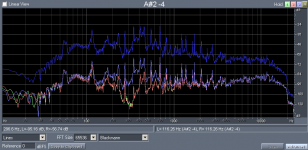
With wire.wav for reference the following analysis is possible:
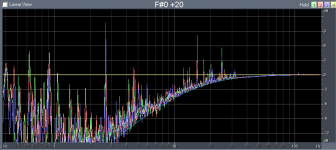
Above was used in determining 14.5Hz filter, seen as clean white trace. Some strong signals are seen above 0dB reference. These could be in source signal, or produced by caps, D/A A/D, or most likely intermodulation of the various system components with each other.
Low frequency view of wire.wav supports system intermodulation theory:
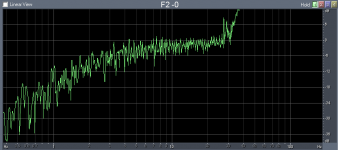
A corner frequency in above is estimated as -3dB referenced to about 30Hz. This could be signal, or high pass behavior of D/A A/D circuit. Obviously, appropriate test signals would resolve all this better than music file.
In spirit of thread it would be nice to add source wavefile as reference. Please post source wave.
Swept sine, and swept sine with various fixed frequencies could resolve intermodulation questions too.
Already, thread shows audible differences of cap in circuit, and of different caps, and that obvious measurable differences exist as well.
This is route to hard science in correlating what is heard, with what is engineered.
Much better than the endless spew and hand waving seen in some of the well attended and bloated threads on the forum.
Pavel, thank you for this refreshing thread.
Frank and Jay, thanks for your first rate ears and keen focus.
Barleywater, thanks again for your excellent analysis. I appreciate it very much. Regarding original file, maybe the shorted version like the 1:01 samples were ... I do not want to violate @. The original is (paid) flac 96kHz/24 bit. Do you have a recommendation how to handle it. flac --> wav? 96/24 or 48/24?
P.S.: I'll probably send you a link in a PM. Please give me one day to do it.
P.S.: I'll probably send you a link in a PM. Please give me one day to do it.
Last edited:
And my thanks to Pavel, Jay and Barleywater. As regards posting the source, my understanding is that up to 30 secs in length is deemed reasonable, as a sampler to the full version.
A snippet that long would be helpful ...
A snippet that long would be helpful ...
OK, here is the sample, in 48/24, and it was matched in level to previous files.
https://www.dropbox.com/s/g7wwamrzl314k03/orig.wav
https://www.dropbox.com/s/g7wwamrzl314k03/orig.wav
BTW, I am still quite confident in a simple ABX foobar comparison between 2 files. The problem was with sorting, because file statistics enables to sort without listening.
So, feel free to post your ABX results between any 2 of those files:
cap1, cap2, cap3, wire.
Only a comparison with orig.wav would be considered invalid, because it is only about 30s long and it is thus trivial to get 100% ABX.
So, feel free to post your ABX results between any 2 of those files:
cap1, cap2, cap3, wire.
Only a comparison with orig.wav would be considered invalid, because it is only about 30s long and it is thus trivial to get 100% ABX.
BTW, I am still quite confident in a simple ABX foobar comparison between 2 files.
It was just explained to me, in a PM, that I am wrong. I have to admit that 🙂
Nevertheless, there are people I trust and I would take into account their result.
Last edited:
I tested the capacitors for DA. They were charged from 4.55V, for 60 sec. Then 10 sec discharging. Then pause of 30 min, and restored DC was measured. It was 7mV for Roederstein and 4mV for Mundorf. Test repeated 3 times, with similar results. Not a big difference between caps.
Anyone, have you tried the original data, orig.wav file? Any impressions?
Anyone, have you tried the original data, orig.wav file? Any impressions?
- Status
- Not open for further replies.
- Home
- General Interest
- Everything Else
- Mundorf polyprop x Rodenstein MKT listening test preparation
